Plot Synopsis (continued)
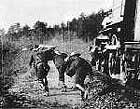 Scene
8: The engine is brought to a stop and the bandits flee: Scene
8: The engine is brought to a stop and the bandits flee:
Farther along on the tracks, several miles from the
scene of the hold up, the four robbers force the engineer to stop
the locomotive. They jump from the train and escape down the side
of the hill next to the tracks (the camera pans after them).
Scene 9: Their escape on horseback:
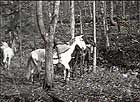 The
bandits run through a beautiful valley, approaching closer into view.
They cross a narrow stream. In a unique, lengthy pan shot, the camera
slowly pans to the left where they mount their tethered, waiting
horses in a nearby wood, and ride off toward the wilderness. The
bandits run through a beautiful valley, approaching closer into view.
They cross a narrow stream. In a unique, lengthy pan shot, the camera
slowly pans to the left where they mount their tethered, waiting
horses in a nearby wood, and ride off toward the wilderness.
Scene 10: The interior of the telegraph office:
Back at the RR telegraph office of the first scene,
the station operator still lies bound, gagged and unconscious on
the floor. His young daughter (Mary Snow) enters the door (her cloak
tinted red) with his dinner pail. She is startled to see him on the
floor. She runs to him, shakes him, and then cuts the ropes that
bind him. However, she is still unable to rouse him. Finally, she
throws a glass of water in his face that brings him to consciousness.
He is able to get to his feet.
Scene 11: The interior of a typical Western dance
hall:
(The director of the film uses an inventive technique
called jump-cutting or inter-cutting, to cover simultaneous actions
in different locales.)
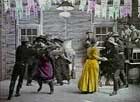 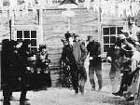 Four
couples are dancing a lively square dance, as others watch standing
against a wall. (A few of the ladies' dresses are tinted yellow and
red). One of the less accomplished, 'greenhorn' dancers, a tenderfoot
dancer (Gilbert M. 'Broncho Billy' Anderson again), is pushed to
the center of the floor and forced to do a jig. Bystanders are amused
and shoot their six-shooters at his feet (seen in a small cloud of
colored smoke) to make him dance faster. He runs from them when he
gets the chance. The experienced dancers resume their quadrille. Four
couples are dancing a lively square dance, as others watch standing
against a wall. (A few of the ladies' dresses are tinted yellow and
red). One of the less accomplished, 'greenhorn' dancers, a tenderfoot
dancer (Gilbert M. 'Broncho Billy' Anderson again), is pushed to
the center of the floor and forced to do a jig. Bystanders are amused
and shoot their six-shooters at his feet (seen in a small cloud of
colored smoke) to make him dance faster. He runs from them when he
gets the chance. The experienced dancers resume their quadrille.
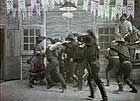 Suddenly,
the door bursts open and the exhausted telegraph operator runs in.
(The film technique of an ellipsis is introduced here - a leap forward
in time by the omission of non-essential material.) He alerts them
to the robbery that has occurred, causing an abrupt end to the dance.
Enlisting a posse, the men grab their rifles and follow him out the
door. They hastily leave the dance hall. Suddenly,
the door bursts open and the exhausted telegraph operator runs in.
(The film technique of an ellipsis is introduced here - a leap forward
in time by the omission of non-essential material.) He alerts them
to the robbery that has occurred, causing an abrupt end to the dance.
Enlisting a posse, the men grab their rifles and follow him out the
door. They hastily leave the dance hall.
Scene 12: The posse chase:
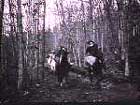 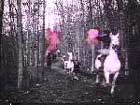 Through
a forested area, the four mounted bandits ride into view, pursued
closely by the large posse. As they ride, they exchange gunfire at
each other, causing smoke (tinted) to blast from the weapons. One
of the bandits is shot and falls from his horse to the ground. He
staggers to his feet and fires at one of the posse members to defend
himself, but is shot dead a few moments later. The posse rides on
after the other three bandits. One of the posse members stops and
looks at the dead body. Through
a forested area, the four mounted bandits ride into view, pursued
closely by the large posse. As they ride, they exchange gunfire at
each other, causing smoke (tinted) to blast from the weapons. One
of the bandits is shot and falls from his horse to the ground. He
staggers to his feet and fires at one of the posse members to defend
himself, but is shot dead a few moments later. The posse rides on
after the other three bandits. One of the posse members stops and
looks at the dead body.
Scene 13: Pursuit and shoot-out:
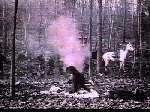 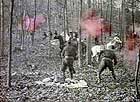 The
remaining bandits have dismounted from their horses. After looking
around and not seeing any danger and thinking that they have eluded
their pursuers, they dump the contents of their pouches on the ground
to examine their 'take.' As they kneel and crouch down and sift through
their booty, they do not notice the members of the posse approaching
on foot from behind - until it is too late. They are surrounded.
A short, ferocious gun battle begins (smoke from the guns is hand-tinted)
and one by one, the bandits are killed. A few of the posse have also
lost their lives. The members of the posse gather up the stolen loot
and confiscate the bandits' guns. The
remaining bandits have dismounted from their horses. After looking
around and not seeing any danger and thinking that they have eluded
their pursuers, they dump the contents of their pouches on the ground
to examine their 'take.' As they kneel and crouch down and sift through
their booty, they do not notice the members of the posse approaching
on foot from behind - until it is too late. They are surrounded.
A short, ferocious gun battle begins (smoke from the guns is hand-tinted)
and one by one, the bandits are killed. A few of the posse have also
lost their lives. The members of the posse gather up the stolen loot
and confiscate the bandits' guns.
Scene 14: A life-size closeup picture of the
leader of the outlaw band:
The film closes with a medium shot close-up of the
bandit chief (with green-tinted shirt and red-tinted kerchief in
some versions) (George Barnes) with his hat pushed back on his head.
He points and shoots his revolver point-blank, directly into the
camera (and, of course, at the audience). This
caused a tremendously terrifying sensation at the time.
|
The Bandit Firing Directly at the Audience
|
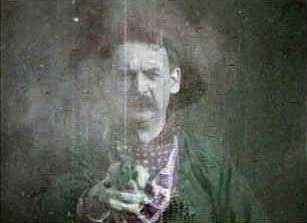
|
[Note: This final punch to the film was totally irrelevant
to the plot. Theater managers were free to either begin or end the
picture with this scene, selecting it as either
a prologue or epilogue -- a promotional gimmick.] |